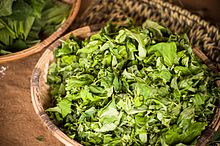Leaf vegetable


Leaf vegetables, also called leafy greens, pot herbs, vegetable greens, or simply greens, are plant leaves eaten as a vegetable, sometimes accompanied by tender petioles and shoots. Leaf vegetables eaten raw in a salad can be called salad greens.
Nearly one thousand species of
The leaves of many fodder crops are also edible for humans, but are usually only eaten under famine conditions. Examples include alfalfa, clover, and most grasses, including wheat and barley. Food processing, such as drying and grinding into powder or pulping and pressing for juice, may be used to involve these crop leaves in a diet.
Leaf vegetables contain many typical plant nutrients, but since they are photosynthetic tissues, their
Nutrition
Spinach, as an example of a leaf vegetable, is low in
The vitamin K content of leaf vegetables is particularly high, since these are photosynthetic tissues and
Preparation

If leaves are cooked for food, they may be referred to as boiled greens. Leaf vegetables may be
Africa

In certain countries of Africa, various species of nutritious amaranth are very widely eaten boiled.[4]
Celosia argentea var. argentea or "Lagos spinach" is one of the main boiled greens in West African cuisine.[5]
Greece
In Greek cuisine, khorta (χόρτα, literally 'greens') are a common side dish, eaten hot or cold and usually seasoned with olive oil and lemon.[6]
At least 80 different kinds of greens are used, depending on the area and season, including
Italy
Preboggion, a mixture of different wild boiled greens, is used in
(Borago officinalis) leaves. Preboggion is also sometimes added to minestrone soup and frittata.[8]Poland
Botwinka (or boćwinka) is a soup that features beet stems and leaves as one of its main ingredients. The word "botwinka" is the diminutive form of "botwina" which refers to leafy vegetables like chard and beet leaves.
United States
In the
Sauteed escarole is a primary ingredient in the Italian-American dish Utica greens.
List of leaf vegetables
- Agastache foeniculum — anise hyssop (western North America)
- Allium fistulosum — Welsh onion (East Asia)
- Alternanthera sissoo — sissoo spinach (Brazil)
- Basella alba — Malabar spinach (India, Southeast Asia, New Guinea)
- Swiss chard
- mustard greens, kohlrabiand more
- Brassica rapa — field mustard, including napa cabbage, bok choy, bomdong, choy sum, komatsuna, rapini, tatsoi, and more
- Campanula versicolor — various-colored bellflower (southeastern Italy to the Balkans)
- Chenopodium quinoa — quinoa (western Andes of South America)
- escarole
- Cichorium intybus — chicory (Europe)
- Claytonia perfoliata — palsingat (western North America)
- Cnidoscolus aconitifolius — chaya (Yucatán Peninsula of Mexico)
- Southwestern Asia)
- Mediterraneanregion)
- Foeniculum vulgare— fennel (southern Europe)
- Gynura bicolor — edible gynura (China, Thailand, Myanmar)
- Gynura procumbens — longevity spinach (China, Southeast Asia, and Africa)
- Hemerocallis fulva — orange day-lily (China or Japan)
- Lepidium meyenii — maca (Andes)
- Lactuca sativa — lettuce, including celtuce, iceberg lettuce, red leaf lettuce, romaine lettuce
- )
- Malva moschata — musk mallow (Europe and southwestern Asia)
- Moringa oleifera — moringa (Indian subcontinent)
- Perilla frutescens — shisho perilla (Southeast Asia and Indian highlands)
- temperate Asia, North America, and Greenland)
- Sassafras albidum — sassafras (eastern North America)
- Sauropus androgynus— katuk (South Asia and Southeast Asia)
- Spinacia oleracea— spinach (central and western Asia)
- Solanum aethiopicum — nakati (Asia and tropical Africa)
- Tropaeolum majus — garden nasturtium (Andes)
- Viola odorata — sweet violet (Europe, northern Africa, Syria)
- Trigonella foenum-graecum - Fenugreek (India)
Postharvest diseases
Common bacterial pathogens include: Xanthomonas campestris pv. vitians, Pseudomonas viridiflava, P. cichorii, and P. marginalis, P. syringae pv. aptata, X. campestris pv. campestris, X. campestris pv. raphani, P. syringae pv. maculicola, P. syringae pv. alisalensis, Pectobacterium spp. including Pectobacterium carotovorum subsp. odoriferum and Pectobacterium aroidearum, Dickeya spp., Pseudomonas marginalis, and Pseudomonas viridiflava.[10]
Common fungal pathogens include:
Common
Fungicides such as prochloraz can be used to manage some of these.[10]
Gallery
-
Gotukola(Centella asiatica)
-
Swiss chard
-
Sabzi Khordan, an Iranian salad-like dish, here of mixed greens and radishes
See also
References
- ^ "Nutrition facts for raw spinach per 100 g; USDA Nutrient Data SR-21". 2014. Archived from the original on 20 September 2014. Retrieved 15 September 2014.
- PMID 24777800.
- S2CID 206036115.
- ^ National Research Council (U.S.), Board on Science and Technology for International Development, Lost Crops of Africa: Vegetables, pp. 6, 35f. Books Archived 20 March 2015 at the Wayback Machine
- ^ "ECHO". Archived from the original on 10 May 2010. Retrieved 6 May 2019.
- ^ Lynn Livanos Athan. "Horta Vrasta – Boiled Leafy Greens". About.com Food. Archived from the original on 20 February 2009. Retrieved 6 June 2012.
- ^ "dall'olio al preboggion". cogornese.it. Archived from the original on 6 March 2012. Retrieved 6 June 2012.
- ^ "Liguria-style omelette with borage and sausage". Italian recipes – Italian food culture – Academia Barilla. Archived from the original on 19 August 2014. Retrieved 8 June 2015.
- ISBN 978-0-9766266-2-6.
Pokeweed must be prepared properly or it is dangerous. ... The only parts of poke to be eaten are the young shoots and tender stem tips, along with their immature, meristematic leaves. These must be boiled in an ample pot of water and then drained. Eating poke raw can cause serious poisoning. ... [A] man became ill from drinking water in which mature poke leaves had been boiled (Jaeckle and Freemon 1981).
- ^ ISBN 9781138630833




